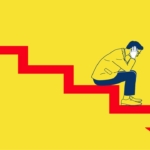Averaging is Bad for You, Here is Why?
A 72-year-old retiree calls a famous TV news channel with a stock market-related query. He’s incurring a staggering loss of 11 lakh rupees on his investment in JP Associates and wants to know whether to wait or exit. He had entered at ₹100 kind of level and now the stock is trading at ₹10.
He is concerned. I could hear his voice.
Now, I have been in the market long enough to see the glory days of JP (went from ₹10 to ₹500) and its fall from grace (from ₹500 back to ₹10 ). The company is mismanaged, business is in legal troubles and the stock is showing no sign of life.
Therefore, I was expecting the TV pundit to be the bearer of the bad news and tell the elderly gentleman to look for an exit at every rally. To my surprise, the so-called “expert” reasoned that the stock has already fallen to single digits, how far can it go? So, his advice was to “average”- i.e. buy more shares of JP Associates so that his purchase price would come down and he could exit early.
I was baffled by what I heard. Not only was the advice wrong but also irresponsible- asking a senior citizen to allocate money in the riskiest of the assets and a bad one at that!
Averaging is a common piece of advice
So, what was wrong with the advice? After all, by averaging are we not bringing our purchase price down? Wouldn’t that make it easier to exit the stock as soon as it shows a bounce?
I will explain that in a minute but let me highlight that averaging is a piece of very common advice. At least once a day, I hear someone say “averaging” on TV or during my mentoring sessions.
Maybe because it is so popular, people have stopped questioning its logic.
The problem with averaging is…
… that it is against the basic tenets of logic.
Let’s say a woman is in an abusive relationship with her husband and the advice she gets from her parents is to show more “devotion and dedication” towards him. What do you think is going to happen? Will the basic nature of the abuser change? No. He will be more empowered to do what he was doing earlier.
This is exactly what we’re doing when committing more capital to an investment that hasn’t worked. Even after the investment has disappointed us repeatedly. we do not accept the simple fact that we were wrong. Instead of taking the losses and moving on, we start committing more and more capital toward it, with the hope that one-day things will turn around.
The problem is that hope is not a strategy and that the bad investment will not turn into good just because we are more committed to it.
Sunk Cost Fallacy
In Behavioral Finance, there’s a concept called sunk cost – any past investment that has already been committed and cannot be recovered. Sunk cost fallacy is the thinking that just because we have invested some resources in something, we should keep committing more because otherwise, all the previous effort will go to waste
Typical examples would be:
- “I might as well keep watching this bad movie because I’ve watched half of it already.” or
- ” I might as well eat the cake (even though I am not hungry) because it will expire.
Does this ring a bell?
We don’t like to “realize” the losses
The fact of the matter is that 11 lakh rupee was a notional loss for that elderly gentleman. It was still not “real” in his mind because there is always hope that things would turn around. We are afraid to book losses because that would make it real and that’s painful.
And who likes pain?
But the problem is that the stock that fell from 500 to 10 can also go down to 5 or 3 or 1. Ugly frogs don’t turn into princes in real life- doesn’t matter how many times you kiss them.
Conclusion
Whenever you plan to put even a single dime into a stock, forget about what has happened in the past. Past is immaterial, past exists only in your mind, past is just the past. Focus on the prospects of the investment: which stock is the strongest in the sector, which stock is strongest on the charts and which stock has the strongest fundamentals?
This will break the vicious cycle of commitment and disappointment. For those of you who are stuck into bad investments/relationships- time to move out and look for better opportunities.
Howdy!
If you’re here for the first time, let’s get introduced.
VRD Nation is India’s premier stock market training institute and we (Team VRD Nation) are passionate about teaching each and every aspect of investing and trading.
If you’re here for the first time, don’t forget to check out “Free Training” section where we have tons of free videos and articles to kick start your stock market journey.
Also, we got two awesome YouTube channels where you can continue the learning process.
Must-Read Articles
Averaging is Bad for You, Here is Why?
A 72-year-old retiree calls a famous TV news channel with a stock market-related query. He’s incurring a staggering loss of 11 lakh rupees on his investment in JP Associates and wants to know whether to wait or exit. He had entered at ₹100 kind of level and now the stock is trading at ₹10.
He is concerned. I could hear his voice.
Now, I have been in the market long enough to see the glory days of JP (went from ₹10 to ₹500) and its fall from grace (from ₹500 back to ₹10 ). The company is mismanaged, business is in legal troubles and the stock is showing no sign of life.
Therefore, I was expecting the TV pundit to be the bearer of the bad news and tell the elderly gentleman to look for an exit at every rally. To my surprise, the so-called “expert” reasoned that the stock has already fallen to single digits, how far can it go? So, his advice was to “average”- i.e. buy more shares of JP Associates so that his purchase price would come down and he could exit early.
I was baffled by what I heard. Not only was the advice wrong but also irresponsible- asking a senior citizen to allocate money in the riskiest of the assets and a bad one at that!
Averaging is a common piece of advice
So, what was wrong with the advice? After all, by averaging are we not bringing our purchase price down? Wouldn’t that make it easier to exit the stock as soon as it shows a bounce?
I will explain that in a minute but let me highlight that averaging is a piece of very common advice. At least once a day, I hear someone say “averaging” on TV or during my mentoring sessions.
Maybe because it is so popular, people have stopped questioning its logic.
The problem with averaging is…
… that it is against the basic tenets of logic.
Let’s say a woman is in an abusive relationship with her husband and the advice she gets from her parents is to show more “devotion and dedication” towards him. What do you think is going to happen? Will the basic nature of the abuser change? No. He will be more empowered to do what he was doing earlier.
This is exactly what we’re doing when committing more capital to an investment that hasn’t worked. Even after the investment has disappointed us repeatedly. we do not accept the simple fact that we were wrong. Instead of taking the losses and moving on, we start committing more and more capital toward it, with the hope that one-day things will turn around.
The problem is that hope is not a strategy and that the bad investment will not turn into good just because we are more committed to it.
Sunk Cost Fallacy
In Behavioral Finance, there’s a concept called sunk cost – any past investment that has already been committed and cannot be recovered. Sunk cost fallacy is the thinking that just because we have invested some resources in something, we should keep committing more because otherwise, all the previous effort will go to waste
Typical examples would be:
- “I might as well keep watching this bad movie because I’ve watched half of it already.” or
- ” I might as well eat the cake (even though I am not hungry) because it will expire.
Does this ring a bell?
We don’t like to “realize” the losses
The fact of the matter is that 11 lakh rupee was a notional loss for that elderly gentleman. It was still not “real” in his mind because there is always hope that things would turn around. We are afraid to book losses because that would make it real and that’s painful.
And who likes pain?
But the problem is that the stock that fell from 500 to 10 can also go down to 5 or 3 or 1. Ugly frogs don’t turn into princes in real life- doesn’t matter how many times you kiss them.
Conclusion
Whenever you plan to put even a single dime into a stock, forget about what has happened in the past. Past is immaterial, past exists only in your mind, past is just the past. Focus on the prospects of the investment: which stock is the strongest in the sector, which stock is strongest on the charts and which stock has the strongest fundamentals?
This will break the vicious cycle of commitment and disappointment. For those of you who are stuck into bad investments/relationships- time to move out and look for better opportunities.















![What is Virtual Contract Note [Zerodha]](https://www.vrdnation.com/wp-content/uploads/2023/10/maxresdefault-virtual-note-500x383.jpg)



Leave A Comment